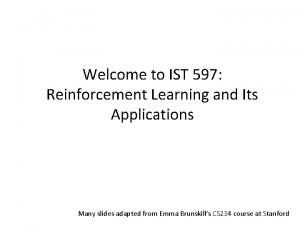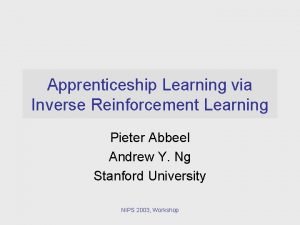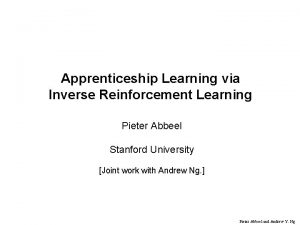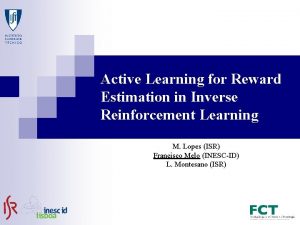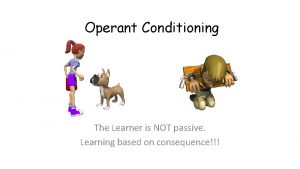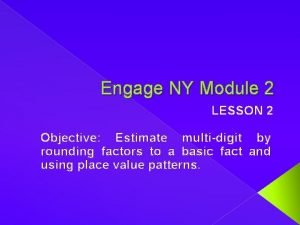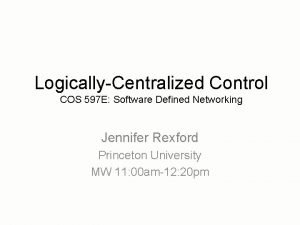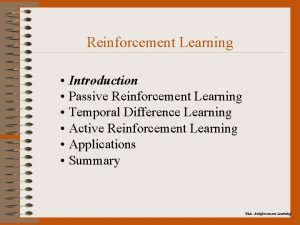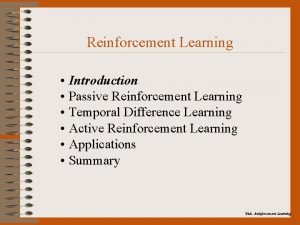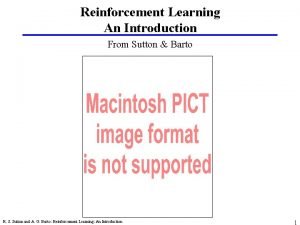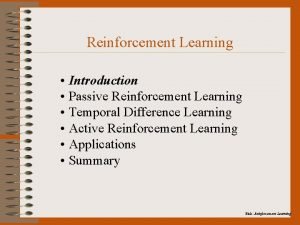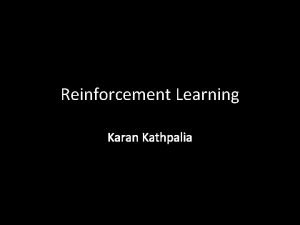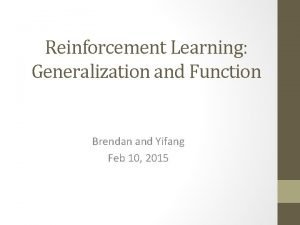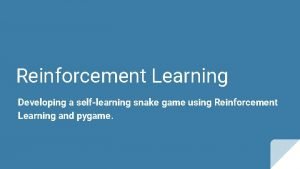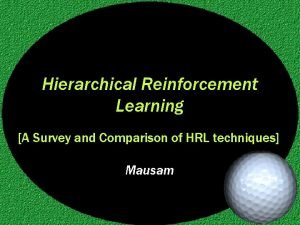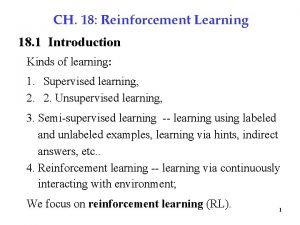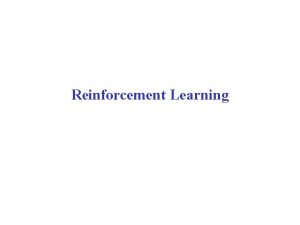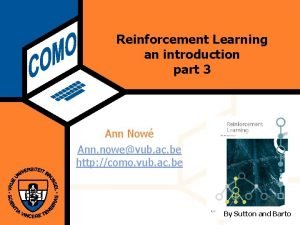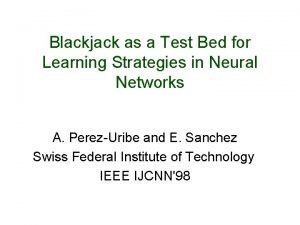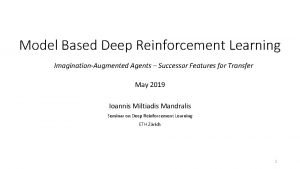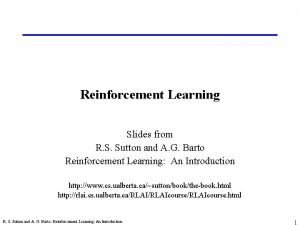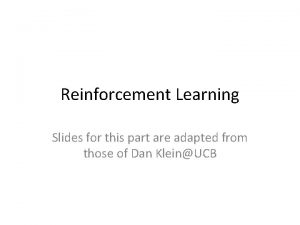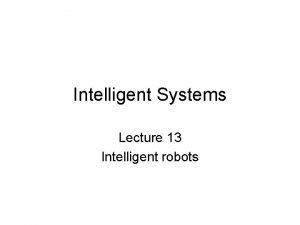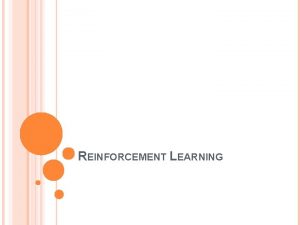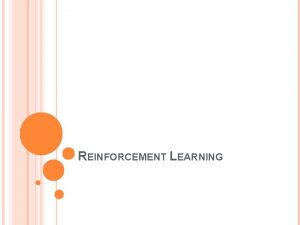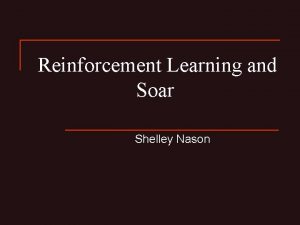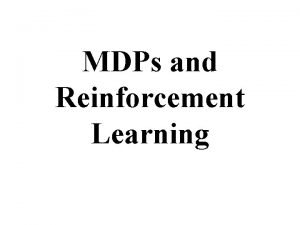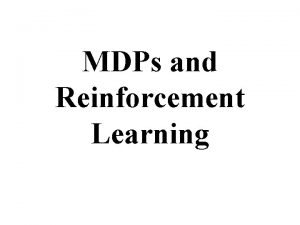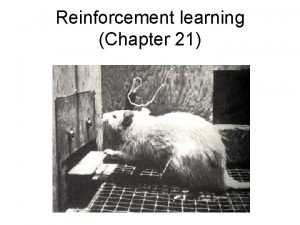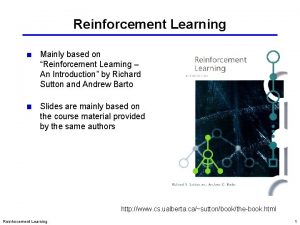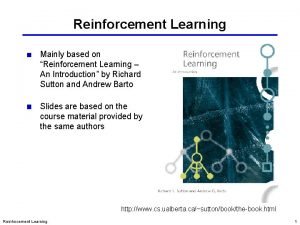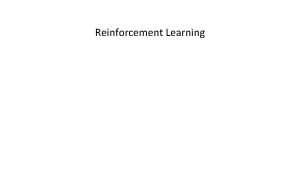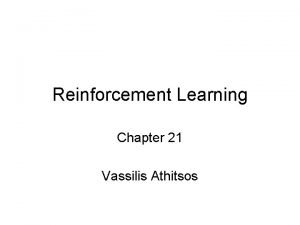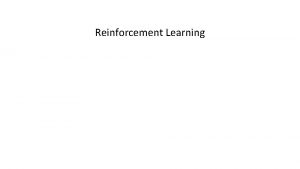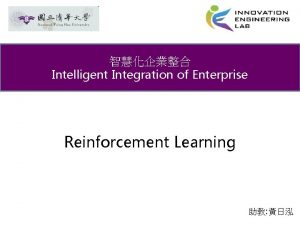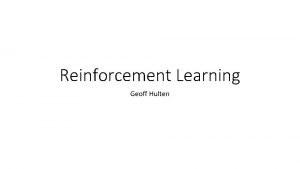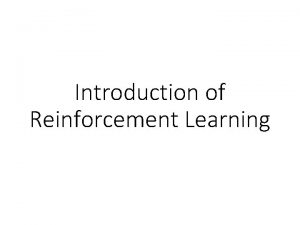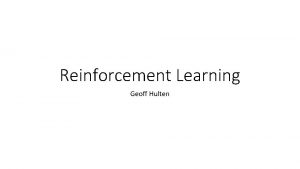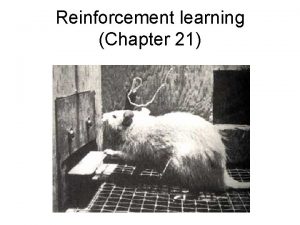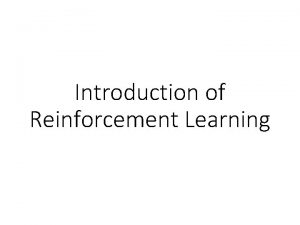Welcome to IST 597 Reinforcement Learning and Its

































- Slides: 33

Welcome to IST 597: Reinforcement Learning and Its Applications Many slides adapted from Emma Brunskill’s CS 234 course at Stanford

Teaching Team • Instructor: Zihan Zhou – – Ph. D in Electrical and Computer Engineering from UIUC Research interest: computer vision, machine learning Office: E 367 Westgate Building Office hour: 2: 00 -3: 00 pm Tuesday or by appointment • TA: Huaxiu Yao – – IST Ph. D student Research interest: data mining, machine learning Office hour: 3: 00 -4: 00 pm Thursday or by appointment Location: E 301 Westgate Building 2

Course Website • Log into your Canvas • Go to Home Schedule – You will see all course information on wikispace 3

What Is Reinforcement Learning? Learn to make good sequences of decisions

What Is Reinforcement Learning? Learn to make good sequences of decisions repeated interactions with world action a World Agent observation o

What Is Reinforcement Learning? Learn to make good sequences of decisions reward for decisions action a observation o reward r

What Is Reinforcement Learning? Learn to make good sequences of decisions don’t know how world works in advance action a observation o reward r

Example: Atari • https: //www. youtube. com/watch? v=V 1 e. Yni. J 0 Rnk What are the observation, action, and reward in the example? Mnih, et al. , 2013. Playing Atari With Deep Reinforcement Learning.

Example: Alpha. Go • https: //www. alphagomovie. com/ • https: //deepmind. com/blog/alphago-zero-learning-scratch/ Silver, et al. , 2016. Mastering the game of Go with deep neural networks and tree search.

Example: Robotics • https: //www. youtube. com/watch? v=CE 6 f. BDHPb. P 8 Levine, et al. , 2016. End-to-End Training of Deep Visuomotor Policies.

Example: Navigation • https: //www. youtube. com/watch? v=2 yj. WDNXYh 5 s Mirowski, et al. , 2018. Learning to Navigate in Cities Without a Map.

Example: NLP • https: //vimeo. com/234955545 Guu, et al. , 2017. From Language to Programs: Bridging Reinforcement Learning and Maximum Marginal Likelihood.

Example: Language and Vision • https: //www. youtube. com/watch? v=R 4 hug. Gn. Nr 7 s&t=283 s Das, et al. , 2017. Learning Cooperative Visual Dialog Agents with Deep Reinforcement Learning.

Example: Healthcare • https: //www. youtube. com/watch? time_continue=187&v=x. Utif. Y 3_1 g. E Wang, et al. , 2018. Supervised Reinforcement Learning with Recurrent Neural Network for Dynamic Treatment Recommendation.

RL Applications • • Business operations Intelligent transportation Education and many more…

Why is RL hard? • Goal is to find an optimal way to make decisions – Yielding best outcomes – Or at least very good strategy

Delayed Consequences • Decisions now can impact things much later • Introduces two challenges – When planning: decisions involve reasoning about not just immediate benefit of a decision but how its longer term ramifications – When learning: temporal credit assignment is hard

Exploration • Learning about the world by making decisions – Agent as scientist – Learn to ride a bike by trial-and-error • Censored data – Only get a reward (label) for decision made – Don’t know what would have happened if had taken red pill instead of blue pill • Decisions impact what learn about – If choose going to Stanford instead of going to Penn State, will have different later experiences…

Generalization • Policy is mapping from past experience to action • Why not just pre-program a policy? Input: Image How many images are there?

RL vs. AI Planning • AI Planning: – computes good sequence of decisions – but given model of the world • Example: Solitaire – single player card game – Know all rules of game – Can compute probability distribution over next state and potential score

RL vs. Supervised Learning • Supervised Learning: – learns from experience – but provided correct labels

RL as Supervised Learning • Imitation learning: – learns from experience – given demos of good policies

RL as Supervised Learning • Imitation learning: – learns from experience – given demos of good policies ot at

Example: NVIDIA AI Car • https: //www. youtube. com/watch? v=-96 BEo. XJMs 0

Imitation Learning • Benefits – Great tools for supervised learning – Avoids exploration – With big data lots of data about outcomes of decisions • Limitations – Data can be expensive to capture – Limited by data collected

How Do We Proceed? • Explore the world & use feedback to guide future decisions • More challenges – Where do rewards come from? – Robustness / Risk sensitivity – Multi agents – ……

How Will This Course Be Taught? • First half: lectures – key concepts – In-class exercises – Discussion on your answers • Second half: student presentations – Each student will sign up for a topic related to RL, and take turns to give an in-depth tutorial to the class. – A list of suggested topics will be provided soon.

Group Project • Work in group to develop, implement, evaluate and document novel ideas in RL and its applications • 2 -3 people per group. • You can choose whom to work with.

Prerequisites • Calculus, Linear Algebra, Probability • Foundations of Machine Learning – familiar with concepts like loss function, derivative, gradient descent • Proficiency in Python – Necessary for implementing algorithms for the course project – unless you plan to focus on RL theory

Readings for Lectures • Text – Reinforcement Learning: An Introduction • Sutton and Barto • 2 nd Edition – Always check the latest schedule in Canvas • Read the text before class is strongly encouraged! – See course website for a reading list before each class

In Class • Attendance and participation – Attendance is required for every class – 15% in final grading – If you are not able to attend class with reasonable excuse, instructor should be notified before class

Grading • Student presentation: 35% • Course project: 50% • Class attendance and participation: 15%

After today’s class • ML quiz
 Ist 597
Ist 597 Apprenticeship learning via inverse reinforcement learning
Apprenticeship learning via inverse reinforcement learning Apprenticeship learning via inverse reinforcement learning
Apprenticeship learning via inverse reinforcement learning Active learning reinforcement learning
Active learning reinforcement learning Positive reinforcement psychology definition
Positive reinforcement psychology definition Round the factors and estimate the products 656 x 106
Round the factors and estimate the products 656 x 106 149 597 871
149 597 871 Hanjun kim
Hanjun kim Cos 597
Cos 597 Winter kommt winter kommt flocken fallen nieder lied
Winter kommt winter kommt flocken fallen nieder lied Meine lieblingsjahreszeit ist der winter
Meine lieblingsjahreszeit ist der winter Es ist herbst bunte blätter fliegen
Es ist herbst bunte blätter fliegen Es ist herbst bunte blätter fliegen
Es ist herbst bunte blätter fliegen Zu glauben ist schwer. nichts zu glauben ist unmöglich
Zu glauben ist schwer. nichts zu glauben ist unmöglich Passive reinforcement learning example
Passive reinforcement learning example What is active and passive reinforcement learning
What is active and passive reinforcement learning Socially mediated negative reinforcement
Socially mediated negative reinforcement Sutton and barto reinforcement learning
Sutton and barto reinforcement learning Active and passive reinforcement learning
Active and passive reinforcement learning Cuadro comparativo entre e-learning b-learning y m-learning
Cuadro comparativo entre e-learning b-learning y m-learning Karan kathpalia
Karan kathpalia Coarse coding reinforcement learning
Coarse coding reinforcement learning Snake game
Snake game Direct reinforcement
Direct reinforcement Hierarchical reinforcement learning survey
Hierarchical reinforcement learning survey What is optimal policy in reinforcement learning
What is optimal policy in reinforcement learning Supervised vs unsupervised learning
Supervised vs unsupervised learning Reinforcement learning exploration vs exploitation
Reinforcement learning exploration vs exploitation Jack's car rental reinforcement learning
Jack's car rental reinforcement learning Neural network blackjack
Neural network blackjack I2a reinforcement learning
I2a reinforcement learning Reinforcement learning slides
Reinforcement learning slides Reinforcement learning slides
Reinforcement learning slides Reinforcement learning agent environment
Reinforcement learning agent environment
